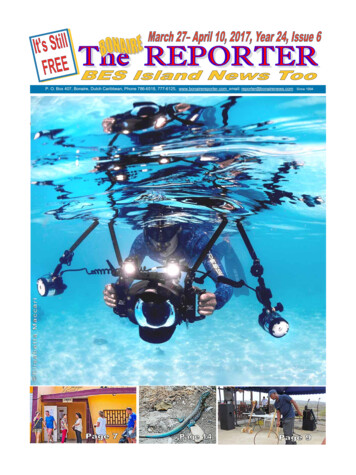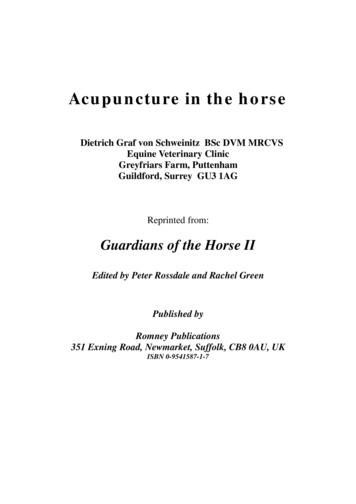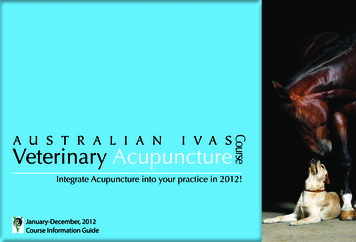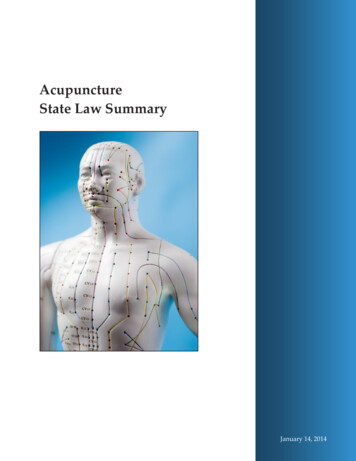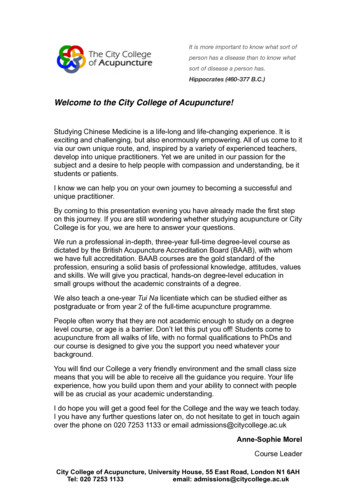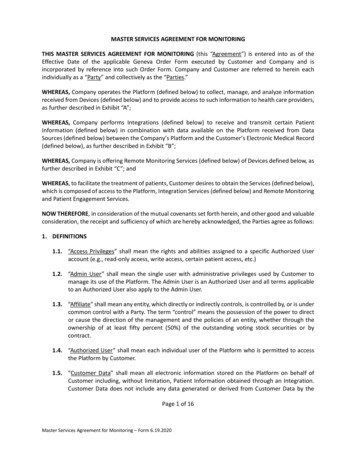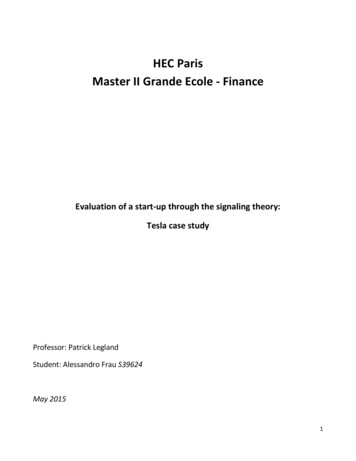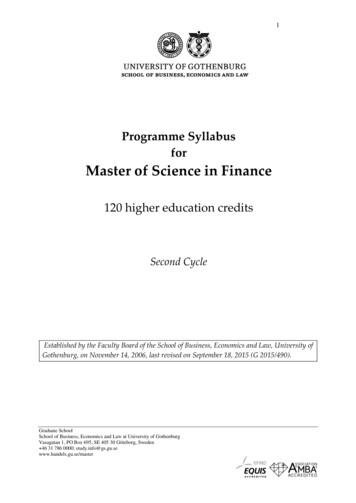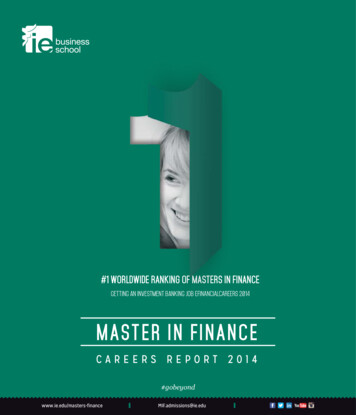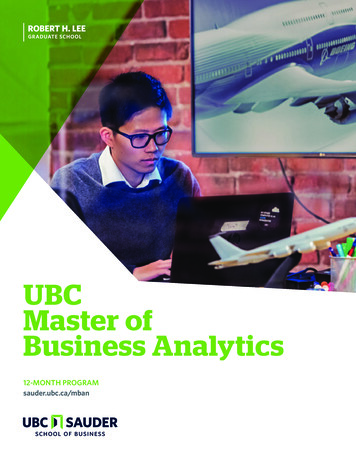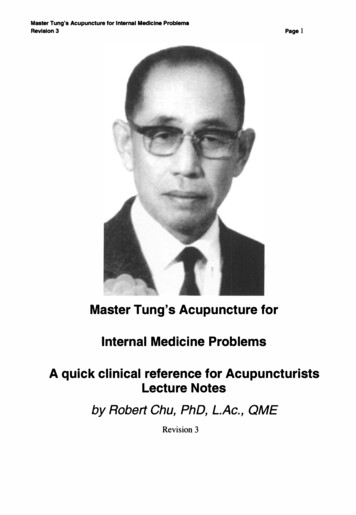
Transcription
Master Tung's Acupuncture for Internal Medicine ProblemsRevision 3Page1Master Tung's Acupuncture forInternal Medicine ProblemsA quick clinical reference for AcupuncturistsLecture Notesby Robert Chu, PhD, L.Ac., QMERevision 3
MasterTung'sAcupunctureforInternalMedicine Probl emsRevision3Page2DisclaimerPlease note that the author and publisher of these lecture notes areNOT RESPONSIBLE in any manner whatsoever for any injury thatmay result from practicing the techniques and/or following theinstructions given within. Since the material deals with priorknowledge of acupuncture described herein, it will be too complex innature for some readers to engage in safely, and it is essential that alicensed acupuncturist be consulted prior to application.These lecture notes are to be used as a supplement when taking acourse with Robert Chu and are not to be distributed to others whohave not taken the course on Master Tung's Acupuncture forInternal Medicine Problemswith Robert Chu.
MasterTung'sAcupunctureforInternal Medicine Probl emsRevision3Page3Note of Abbreviations used in this textIn this text we use the following abbreviations for the variouschannels:Lu Lung ChannelLl Large Intestine ChannelSt Stomach ChannelSp Spleen ChannelH Heart ChannelSl Small Intestine ChannelUB Urinary Bladder ChannelK Kidney ChannelPc Pericardium ChannelSJ Sanjiao ChannelGB Gallbladder ChannelLiv Liver ChannelRen Ren ChannelDu Du Channel
Master Tung'sAcupuncturefor Internal Medicine ProblemsRevision3Page4Author's Preface:Although Master Tung's Acupuncture has been in the public domain since hisuntimely passing in1975,very little information is available publicly on how touse the system in a practical and systematic way in English. In these lecturenotes, I hope to guide my fellow colleagues into the intricacies of applying MasterTung Acupuncture in the clinic.Since I am also a practicing martial artist anddeal with internal medicine problems, sports injuries, pain management, andworker's comp injuries quite frequently, I wrote these lecture notes based on myclinical experience based on the protocols that I use daily.Each of theseprotocols has been personally used by me one time or another in the clinic.Since I am a visual person, and I like things in a simple manner, I have placedthe pictures of the points indicated for the various ailments together, to make it assimple as possible for the practicing acupuncturist to use in his or her clinic. Idislike overly drawn out discussions on theory, but prefer that application beone's guide. I also dislike secrecy, so I hold back no "alleged" secrets fromanyone who wants to learn the real art. My goal is to help end suffering in theworld and help English speaking acupuncturists improve their proficiency throughthe vehicle of Master Tung's Acupuncture.Many get overwhelmed when they refer to other media on Master Tung'sAcupuncture. The existing numbering system is poor and nonsensical, thenames of the points are all in Chinese, and the English translations of the namesare poorly selected, and even worse, point locations are off. Some havedeliberately tried to differentiate Master Tung's Acupuncture and regularacupuncture by stating that it is "non-channel acupuncture" - nothing could befurther from the truth!
MasterTung'sAcupunctureforInternal Medicine ProblemsPageSRevision3Also, little is done to approach the body of work on Master Tung's Acupuncture ina practical manner, and for one to use clinically on a daily basis. It is hoped thatthe reader can use these few points here and achieve amazing results in his orher practice, as these are the same points I use in my own practice daily withamazing results!In future revisions of this work, I will further explain the use of the points and theirapplication in more difficult diseases. It is hoped that reader's questions andinterest will lead to new revisions of these lecture notes.I would like to thank my teacher, Dr. Young Wei-chieh, for instructing me in thismethod that he learned from Master Tung Ching-chang, and I would like toacknowledge Esther Su, a renowned master of Tung's Acupuncture, for hergenerous help.I would also like to thank my students Jack Chang, KariPurhonen, Robert Ting, Dave McKinnon and Theodore Zombolas for theirwonderful photography and artwork!
MasterTung'sAcupuncturefor Internal Medicine ProblemsRevision3Page6Getting started Master Tung's Acupuncture consists of 740 family points in all,plus unique applications of the 14 channel points. All thepoints are distributed on the 14 channels, or found between thechannels. Clinically, it is not important to use them all. In myexperience, 20 - 30 points are all that are needed in generaldaily use. One could also say that a working knowledge of a100 or so points is all you would ever need. Master Tung'sAcupuncture attempted to establish a numbering system invarious books in Chinese, but it is easier to memorize theChinese names, as they relate to the function of that point. Thenumbering system is poorly conceived and theoreticallydistributed amongst 12 portions of the body. They have norelevance clinically. In needling, you can needle arbitrarily any side of the disease.The Huang Di Nei Jing Su Wen's Miu Ci chapter and the LingShu's chapteron the 9 needles, 12 Yuan Source suggest thatone can needle in the opposite side.However, if the disease isbilateral, we may choose to needle bilaterally. Generally, inclassical acupuncture, needling is applied on the left for men,and right for women. In my clinical experience, it matters littlewhich side you actually needle as the human body is oneorganism and always strives for balance and homeostasis.
MasterTung'sAcupunctureforInternal Medicine ProblemsRevision3Page7Points on limbs, ears, head, and face treat general disordersand are generally treated with fine needles. In bloodletting, we usually blood let on the same side. It isthought that bloodletting is older and faster than retaining fineneedles of acupuncture. Bloodletting is also better for chronicor stubborn diseases, especially if there is blood stasis orphlegm involved. Bloodletting is generally done in the Westernclinic with a lancet and cupping on chosen points. It is advisedbloodletting to the bone is cautioned against.Points on chest,abdomen, and dorsal areas are usually bloodlet, but distalbloodletting is also done. The Chinese custom of sharpeningthe triangular needle is discouraged, as this does not followClean needle protocol, as well as even the use of the triangularneedle, as few develop the proper skill to adequately use this.In some areas of the USA, the triangular needle is forbiddenand appears to be a surgical instrument to the untrained eye. Needling is applied with a simple guide tube and disposableneedles and retained for about a half hour clinically. Of course,one should observe proper needle angle with straight ordiagonal insertion necessary when needling the torso or overvital areas. Generally, one does not have to manipulate theneedle with Tung's Acupuncture.
MasterTung'sAcupunctureforInternal Medicine ProblemsRevision3 Page 8Dr. Young Wei-Chieh introduced and clarified the technique ofMoving Qi, which is used in lieu of manipulating the needle fortonification or sedation. Basically, Dr. Young taught theconcepts of:Qian Yin Zhen (pulling Needle) - amethod in which to guideneedle sensation by using a point distal to the affected area orchannel.Xi Qi (Breathing Qi) - theconcept of breathing energy into theaffected area, akin to the intention used in Qigong practicesHuo Qi (Moving Qi) -when a patient is needled distally, he isasked to move the affected areaAn Mo (Massage)- inthis method, the practitioner massagesthe affected area to guide energy to that area. Point succession technique: Master Tung taught Dao Ma Zhen(Needling in succession) - this is a technique unique to MasterTung's Acupuncture in where needling is performed insuccession to emphasize a particular channel and send asignal to the brain to restore the body in harmony." This hasbeen emphasized by works by Dr. Young Wei-chieh and otherTaiwanese authors. Source: Dong Shi Qi Xue Zhen Jiu Xue,by Young Wei-Chieh, Zhi Yuan Publishing, Taiwan 1992 andTaiwan Dong Shi Zhen Jiu Dao Ma Zhen Ci Liao Fa,by LiGuo Zhen, Zhi Yuan Publishing, Taiwan 1994, and Advanced
MasterTung'sAcupuncturefor Internal Medicine ProblemsRevision3Page9Tung Style Acupuncture: The Dao Ma Needling Techniqueof Master Tung Ching-Changby James H. Maher, DC, OMD,Dipi,Ac., self published, 2004, ISBN 0-9759096-9-X. Each digit of the hand is divided into 8 lines. Dr. Young in hisbook, Dong Shi Qi Xue Zhen Jiu Xue, Zhi Yuan Publishing,Taiwan 1992, named the palmar side lines as named A throughE, I named the lines F - H, on the dorsal side, following hisexample. This helps in locating the points on the fingers:Line A is the radial side of the finger, at the junction of the redand white skinLine 8 is the bisecting line between Line A and Line CLine C is the palmar centerline of that particular fingerLine D is the bisecting line between Line C and Line ELine E is the ulnar side of the finger, at the junction of the redand white skinLine F is the bisecting line between Line E and Line GLine G is the dorsal centerline of the fingerLine H is the bisecting line between Line G and Line A
MasterTung'sAcupuncturefor Internal Medicine ProblemsPage 10Revision3Please refer to the diagram below:GH/FAEDBc
MasterTung'sAcupuncturefor InternalMedicine ProblemsRevision3The relationships of the channelsPagellSources: Personal Notesfrom Lectures by Dr. Young, Robert Chu 2001-2005, Acupuncturist'sHandbook Revised Edition by Kuen Shii Tsay, Published: 1996, ISBN: 09647445-0-3, Zhong Hua Ji He Xue, by Liu Yan, Shang Hai Ke Xue Publishing,China 2002, and Dr. Tan's Strategy of Twelve Magical Points, AdvancedPrinciples and Techniques in Acupuncture by Richard Tan, self published 2003,and my own personal notes in Dr. Tan's lectures, Robert Chu, 2001-2004. Channel Relationship to itself (Tong Jing) - every channel cantreat itself; for example, if there is a problem with the Stomachchannel, choose the Stomach channel Hand and Foot Relationship (Tong Ming Jing) - This is thesame channel name relationship, for example, Both the Lungand Spleen are Tai Yin; therefore use the Lung to treat theSpleen. Since the Yang Ming channel is composed of theLarge Intestine and Stomach Channels, use them to treat eachother. Biao Li Relationship ( Interior/Exterior Channel relationship) This is the common Internal external relationship found in TCM.For example, use Lung Channel to treat the Large IntestineChannel. The rest follow accordingly. Zang Fu Bei Tong or Bie Jing Relationship (Branching ChannelRelationship) -There are 3 sets of Branching relationship: Tai
Mas terTung's AcupunctureforInternalMedicine ProblemsRevis ion3Page 12Yang and Tai Yin treat each other, Shao Yang and Shao Yintreat each other, Yang Ming and Jue Yin treat each other
MasterTung'sAcupuncturefor Internal Medicine ProblemaRevision3Page 13Some Principles of Master Tung's Acupuncture: On the affected channel, treat the channel. Using a related channel, you can include or not include theaffected channel. Use the corresponding area when imaging to produce the bestresults. Use the elements to treat problems. Use levels to treat problems.
Master Tung'sAcupuncturefor Internal Medicine ProblemsPage 14Revision3 The Relevance of 5 elements and corresgondencesIn the Su Wen Chapter 4, which discusses the5 element correspondences,wenote that if we needle a red color, we can treat the heart, and that if we needlethe spine, we can treat the spleen. Needling the affected correspondence of theFive elements will affect the particular organ the tissue is related to.I have summarized these in a chart:ElementYin OrgansFIREHeart ng OrgansIntestine &StomachSan JiaoSense essFearAngerSeasonsSummerLate n
MasterTung'sAcupunctureforInternal Medicine ProblemsRevision3Qi TransportsManifestationChestFaceSpinePage HairtriangularpointedBody Typesfeatureslarge featuresfeaturessmall handsstrong legsstrong voicequickcalm generousmeticulous,strong willedenergeticHead Hairroundfeaturesstrongdigestionloyal, enjoymovementFor example:i;i Needling the thighs will treat Kidney problemsi;i Treating the Neck will treat Liver and Gallbladder problemsi;i Needling around the lips will treat the Stomach and Spleen Needling the face will treat the HeartNeckNailstallslenderstrongbones andjointshardworkers
MasterTung'sAcupunctureforInternal Medicine ProblemsRevision3Page 16Internal MedicineChart of the causes of diseaseEmotionalLack ofPoor Diet eTraumaStress Weather Pollution Toxins Preservatives FashionElectromagneticfieldsGeneticFactors
MasterTung'sAcupunctureforInternal Medicine ProblemsPage 17Revision3Master Tung's Acupuncture for Internal MedicineProblems:Upper Respiratory TractAcute sinusitis1) Si Ma SanSi Ma Zhong; Si Ma Shang; Si Ma Xia/ Rapid Horses Middle, Upper,and Lower, known collectively as Si Ma SanLocation: Si Ma Zhong is found 4 fingerbreadths anterior to GB 31, SiMa Shang is 2 cun superior, Si Ma Xia is 2 cun inferior.
Master Tung's Acupuncture for Internal Medicine ProblemsRevlslon32) Men JinMen Jin/ Door GoldLocation: This point is located at St 42.Page 18
Master Tung's Acupuncture for
Taiwan Dong Shi Zhen Jiu Dao Ma Zhen Ci Liao Fa, by Li Guo Zhen, Zhi Yuan Publishing, Taiwan 1994, and Advanced . Master Tung's Acupuncture for Internal Medicine Problems Revision 3 Page9 Tung Style Acupuncture: The Dao Ma Needling Technique of Master Tung Ching-Chang by James H. Maher, DC, OMD, Dipi,Ac., self published, 2004, ISBN 0-9759096-9-X. Each digit of the hand is divided into 8 lines .
